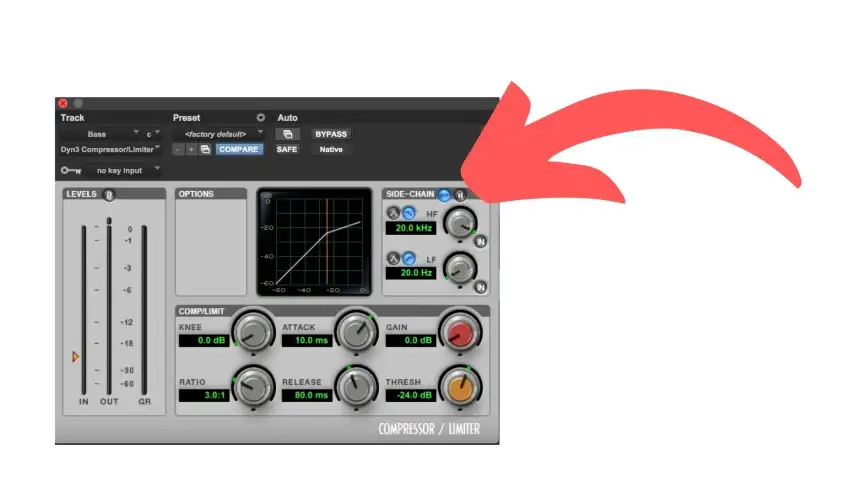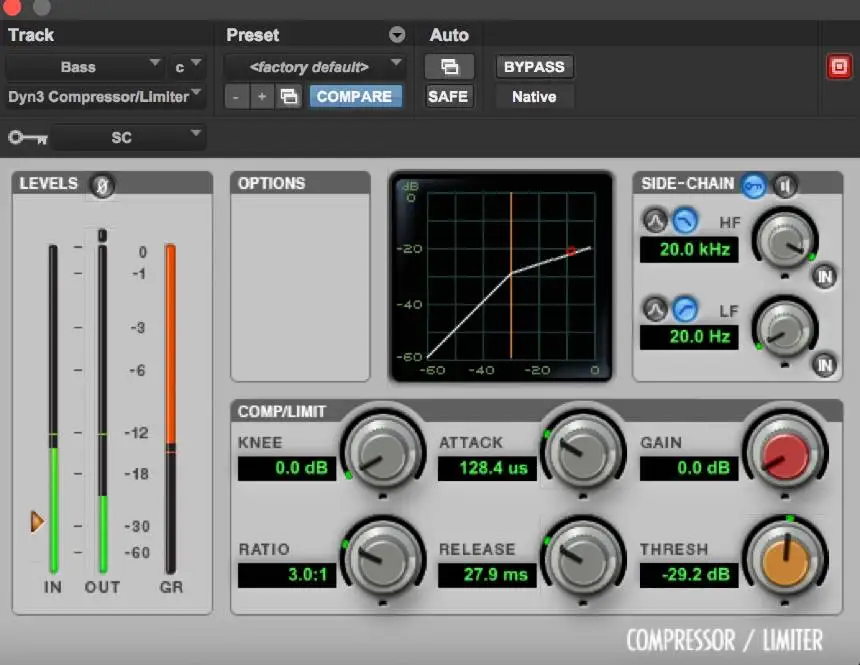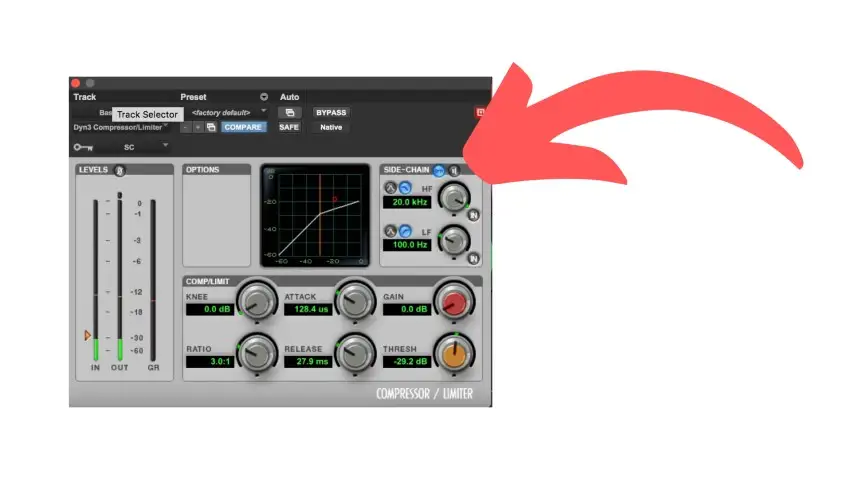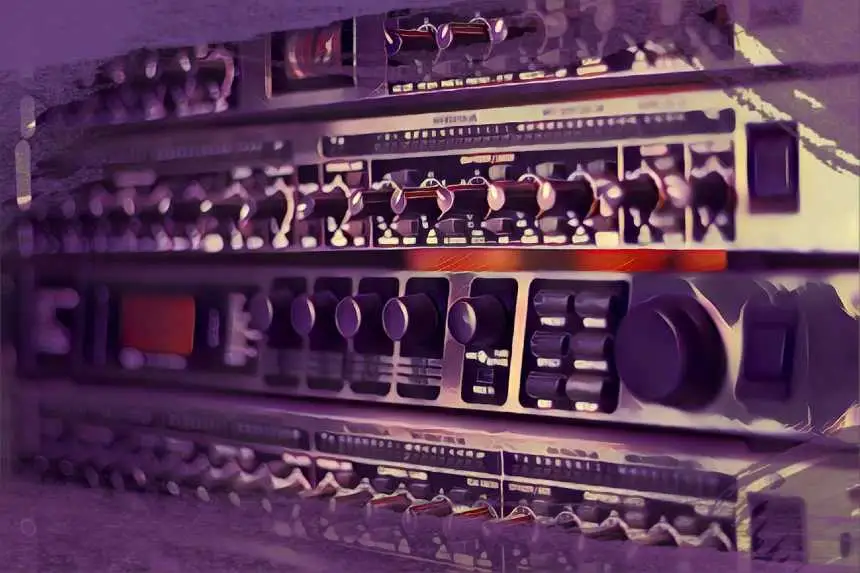Sidechain compression is one of those techniques that often baffles young producers, though it can be one of the most powerful tricks in your production toolbox once you know how to use it effectively.
And no, it is NOT exclusive to EDM producers.
In this guide, we're going to discuss what is side chain compression, why it is so important and give you a few ways to implement sidechain compression in your mixes.
What Is Sidechain Compression?
So, how might one use sidechain compression in their tracks?
Well, let's start with compression in its most basic form.
Compression is a tool that controls dynamic sources. Before regular compression, engineers had to ride faders to manage peaks and valleys in volume. When the compressor was invented, engineers had a unique way to automate that control.
Sidechain compression is very similar in that you deal with all of the same parameters as a compressor, including the threshold, attack, release, and ratio.
However, the "sidechain " is what separates this technique from a compressor's standard intelligent volume control.
With a regular compressor plugin, you can control the channel on which your plugin is inserted. When you engage the compressor's sidechain input, the compress begins monitoring a different sound source .
For example, one might place a compressor on a bass guitar track and set the sidechain to the kick drum, meaning the kick drum is the track that will control the compressor.
In this situation, whenever the kick drum hits and gets loud, the compressor will clamp down on the bass guitar.
Now, you might be asking yourself,
Does the compressor in my DAW have a "sidechain input," or do I need a special plugin?
What Is A Sidechain Compression Plugin?
If you're using sidechain compression in Ableton, Logic, or Pro Tools, the stock compressors come with sidechain input. However, many producers use special tools with factory sidechain presets to get the best sound. The majority of these plugins focus purely on sidechaining.
Some of our favorites include:
- Kickstart by Nicky Romero
- Shaperbox 2 by Cableguys
- LFO Tool by Xfer Records
- Trackspacer 2 by Wavesfactory
History of Sidechain Compression
The history of sidechain compression dates back quite a way before electronic music became popular.
In fact, one of the earliest evolutions of the idea came from overcompressing a signal.
Let's take a drum kit, for example. If you slap a compressor on the drum bus and compress the life out of it, you'll probably notice the kick dominating the compressed sound, nearly muting the softer sounds (such as the cymbals and hat) every time it hits.
One significant early example of this can be found in Tomorrow Never Knows by The Beatles:
You'll notice that each time the kick and snare hit, the cymbals dip out and become a white noise-like blur.
Eventually, during the late 90s, dance music took over.
Of course, the main focus of dance music, as it has always been, is the drums. The most essential drum in the mix is the kick drum.
No matter what was happening atop the kick drum in a dance track, that kick needed to be heard loud and clear to keep the crowd moving. It was during this time we saw electronic music artists beginning to sidechain their melodic tracks to the kick drum in very blatant manners to get it to hit.
You can hear an early example of this in Daft Punk's hit, One More Time :
During this same time, hip-hop pioneers in the 90s began taking sidechain compression into their own hands to see who could create the hardest-hitting drums.
With a quick listen to J Dilla's Dime Piece , you can hear the entire track is side-chained to the kick drum.
Benefits of Sidechain Compression
One of the clear benefits of sidechain compression is clarity .
Producers and engineers use this technique to get other, less important instruments out of the way for the ones they want to focus on. Whether the primary instrument is the kick drum, the bass track, or the vocals is entirely up to the producer or engineer.
Sometimes we'll be mixing, and we want the best of both worlds. For example, we might want the kick drum to hit hard with a subby low-end and rich low-mids. However, we also want our bass line to have a deep sub and girthy low-end as well.
It's often hard to have both of these things while exclusively using EQ , as they share the same frequency range. However, by putting a sidechain compressor on your bass track and routing the compressor's sidechain input to the kick track so that every time the kick plays, the bass line drops out for a split second, you CAN get the best of both worlds.
A Step-By-Step Guide To Sidechaining Your Compressor
The first thing you need to do is get a compressor plugin that is capable of sidechaining . Most popular DAWs come with stock sidechain compressors, so you're in luck.
Once you have your compressor, follow these steps:
#1 Add Your Compressor To The Track Your Want To Duck
The compressor will go on the track with the audio signal that you want to duck. This is typically the less important track that you want to get out of the way of the significant track. To show you how to do this, I will use the stock compressor in Pro Tools.
I'll start by placing the compressor on an insert slot on the bass channel.

#2 Sidechain to The Track The Requires More Clarity
On the top right of this plugin, you'll find the "sidechain" button. This will look a bit different on every plugin, though the method is the same. Once you've engaged your sidechain, route it to a send in the top left corner. For this example, I've chosen Bus 27-28 .
I will then go to my kick drum track and create a send to Bus 27-28 so that the sidechain compressor can pick it up.

#3 Adjust the Settings
At this point, every time the kick drum plays, the bass signal should drop. You'll want to adjust the settings to taste for your track. We recommend starting with a 2:1 ratio and lowering the compressor's threshold until you hear the amount of gain reduction you want.
For a more subtle approach, we recommend 2-3 dB of gain reduction. However, if you want very apparent, EDM-style sidechain compression, you can crank the threshold.
Next, adjust the attack time . Typically , you'll want the attack time to be reasonably fast (somewhere around 2ms or less). Remember, you want your less important signal (bass guitar) to get out of the way immediately every time your kick hits.
When it comes to the release time , it's more up to taste.
We recommend starting with a fast release time under 50ms if you want to keep it subtle. However, for dance music, where rhythm is essential and sidechain compression is more prominent, you might consider timing the release to the track.

Common Uses of Sidechain Compression
Creating Room for Your Kick
As we said before, the kick and bass share the same frequency range, making it difficult for engineers to get their kick drum signal to pop through without muddying up the low end.
If you want the best of both worlds, we recommend using sidechain compression in conjunction with EQ to obtain a kick and bass balance without compromising their tone. In most cases, you can place a sidechain compressor on your bass track and route the input signal of the sidechain or key input so that each time the kick hits, the bass drops out.
Creating Lead Vocal Clarity
One technique I often find myself using is sidechaining the vocals that I'm mixing to the other instruments in my mix. While you can use regular vocal compression to push your vocals to the front, it doesn't always work the way you hope.
For example, if I find that the guitars, synths, or backing vocals are covering up the leads, yet I don't want to compromise their tone with EQ, I'll often sidechain them to my lead vocal track.
You must use a fast attack and a fast release (below 30ms) for this technique to work. Each time the lead vocal hits, the instruments side-chained to it should drop out immediately and come up quickly after they're gone. Shoot for around 1-3dB of gain reduction.
Many engineers even go as far as sidechaining their lead vocals to all the tracks to ensure they stay upfront the entire song.
Pumping
Pumping is one of the iconic techniques in EDM music. While this technique is used by just about everyone and their mother these days, we can thank the pioneers of dance music like Daft Punk and Eric Prydz for making it popular.
You've likely heard this technique in action before.
Typically, an EDM producer will sidechain instruments to the kick drum to duck out every time the kick drum hits. Unlike the other two common uses above, which are subtle mixing tricks, this is more or less a creative effect.
Use extreme settings on your compressor and time out the release to sync with the track's tempo .
PRO TIP: To figure out how to time your release, you can use the equation:
60,000/BPM = Quarter Note In (ms) .
For example, let's say you're working with a track at 120BPM. You can plug that BPM into the equation to determine that a quarter note is 500ms .
(60,000/120 = 500ms)
If you want your release to be as fast as an eighth note, you can divide that number by two.
(500/2 = 250ms)
However, if you're working with a track with a half-time feel, you might consider doubling that number.
(500 x 2 = 1,000ms)
Uncommon Uses of Sidechain Compression
Ducking Reverb and Delay
In pop music especially, it's essential to keep the vocal upfront and in your face. However, if you want to place reverb and delay on your vocal, keeping it in the front of a mix becomes challenging.
One unique way producers can put massive reverb settings on pop vocals without drowning them out is by sidechaining their reverb and delays to the lead vocal.
Simply create a bus for time-based vocal effects and place a sidechain compressor on that bus. Then, route it to the lead vocal so that the effects dip out every time the vocalist sings a line.
Reducing Snare in Overhead Mics
If you record live drum kits, you've probably run into the problem of having too much snare in your overheads. To remedy this common problem, you can set a compressor on your overheads and route the snare as the trigger signal so that each time your snare plays, it dips out in the overheads.
Lo-Fi Hip-Hop Vinyl Noise
Most amateur lo-fi hip-hop producers will smack a looped sample of vinyl noise on their tracks and call it a day. However, experienced producers will take it a step further by interlacing that vinyl noise to make it a part of the track .
One of my favorite things to do when producing lo-fi hip-hop is finding a good vinyl noise sample and loop it through the track. I'll then slap a compressor on it and use the kick and snare as triggers. Each time the kick and snare play, the vinyl noise will slowly dip out.
By doing this, you add to the rhythm of your track while gluing the noise to the drums so that it sounds more realistic.
Examples of Sidechain Compression in Music
"One More Time" - Daft Punk
We have to give credit where credit is due. We know you've probably heard this song a million times at this point, though it's one of the best and earliest examples of proper sidechain compression in dance music.
At 0:45, a kick drum comes into the mix. If you listen carefully, you can hear the bass dip out each time the kick plays, giving the track a unique pumping effect and ensuring kick clarity.
"Hey Mr. Tree" - Amon Tobin
For a wacky and wild example of sidechaining, check out Amon Tobin's "Mr. Tree."
Amon uses this technique in just about all of his tracks, allowing the kick to cut through each part of the mix, creating glitchy and swooshy effects for unique rhythms and hard-hitting drums.
"Never Catch Me" - Flying Lotus
Sidechaining has been a significant part of hip-hop production since the J Dilla era, though you can still hear it on modern hip-hop tracks. A great example of it can be found on Flying Lotus' "Never Catch Me," around 3:45.
The kick drum blasts through the entire mix like a series of gunshots.
Sidechain Compression Tips & Tricks
Ignoring Low-End Frequencies
Advanced mixing engineers often use sidechain compressors that ignore the low-end to get clean compression without pumping artifacts.
Most stock EQs come with frequency sidechain controls.
You can engage these controls to prevent your sidechain input from monitoring specific frequencies.
A great example of this is mix bus compression .
Lower frequencies are far more powerful than higher frequencies. Therefore, if you place a compressor on your mix bus, hard-hitting peaks in the low-end will trigger it before anything else, often leading to unwanted pumping.
While modern compression in mastering will keep your high-frequency instruments under control, such as your guitar, vocals, or synths, it will clamp down on the mix each time your 808 hits or your bass plays a low note.
You can avoid this by using a compressor with a built-in frequency sidechain. We recommend setting your high-pass filter on your compressor to 100Hz to start and adjust to taste.

Isolating Frequencies
You can apply your sidechain effect to specific frequencies if you have a multiband compressor in your plugin toolbox . In this instance, you only apply the sidechain to trigger when a particular frequency range gets out of control.
For example, let's say you have a guitar solo in a heavy rock track and you want the high-mids to cut through the wall of rhythm guitars, though you don't want to EQ the high-mids out of those rhythm guitars and lose bite.
Instead, you can place a multiband compressor on the rhythm guitar bus and route your solo guitar's audio signal to the sidechain of the high-mid frequency band. Again, similar to the lead vocal technique above, you'll want to use a fast attack and a fast release.
Each time your solo guitar plays a note, the high-mid frequencies dip out of your rhythm guitars.
FAQ
Why Is It Called Sidechain Compression?
In the 1930s, Douglas Shearer coined the term when he created a compressor that used a "side" signal chain, which was a different parameter than the main compressor trigger. This side signal used an EQ and could only be triggered when a specific frequency appeared.
What Is The Point of Sidechaining?
One of the main points of sidechaining is creating clarity in a mix. You can use a compressor's sidechain to help an instrument cut through in a mix without compromising the tonal characteristics of the other instruments that are masking it.
Is Sidechain Compression Necessary?
While sidechaining isn't necessary, by any means, it is one of the most helpful techniques in modern music production for creating clarity, whether you're using it on vocals, drums, bass, synths, keys, or guitars. In EDM, it has become a staple technique.
How Do You Sidechain Your Voice?
To sidechain your vocals, determine what instrument you would like to sidechain them to. If it's your kick, for example, you can place a compressor on your kick drum channel and send your vocals to the input so that every time your kick hits, your vocals dip out.
Do You Have To Sidechain Kick and 808?
If you're using a kick with a sharp transient, then there is no reason to have one on your 808 that will compete with it. To get rid of this sharp transient, you can either use a transient shaper or sidechain your 808 to your kick so that the transient dips out each time your kick drum hits.
Can You Sidechain Reverb?
Sidechaining reverb is a common music production technique to get reverb out of the way when the dry signal plays. For example, one might sidechain their reverb to their lead vocal so that the sound of the reverb dips out when the vocalist sings a line. This technique helps create clarity.
What Genres of Music Use Sidechaining?
While sidechaining became popular through EDM and hip-hop, it has slowly made its way into just about any genre. While its use might be more subtle in modern rock or pop records, it certainly has a place through different genres in the music industry.
How Do You Sidechain Certain Frequencies?
To sidechain certain frequencies, you can use a multiband compressor or a dynamic EQ . For example, you might set your bass guitar's multiband compressor's sidechain so that 50-100Hz dips out each time your bass drum hits.





